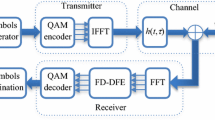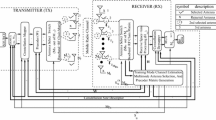Abstract
In this paper, packet throughput is analyzed and simulated for a show FH/SSMA packet radio network with adaptive antenna array and packet combining in a Rayleigh fading channel with shadowing. The packet throughput is defined as the average number of captured packets per slot. To enhance the throughput performance, an adaptive spatial filtering through adaptive antenna array and a packet combining scheme are employed. As a random access protocol, slotted ALOHA is considered, and synchronous memoryless hopping patterns are assumed. A packet consists of codewords from an (n, k) RS (Reed-Solomon) code. The tap weights of an adaptive processor is updated by RLS (recursive-least-square) algorithm. From the simulation results, it is shown that a pre-processing by adaptive antenna array and a post-processing by packet combining are very effective to improve reception performance of an FH/SSMA network.
Similar content being viewed by others
REFERENCE
M. B. Pursley, “The role of spread spectrum in packet radio network,” Proc. IEEE, vol. 75, no. 1, pp. 116–134, Jan. 1987.
Y. R. Tsai and J. F. Chang, “Using frequency hopping spread spectrum technique to combat multipath interference in a multi accessing enviroment,” IEEE Trans. Veh. Technol., vol. 43, no. 2, pp. 211–222, May 1994.
K. Yang and G. L. Stuber, “Throughput analysis of a slotted frequency-hop multiple-access network,” IEEE J. Select. Areas Commun., vol. 8, no. 4, pp. 588–602, May 1990.
K. Bakhru and D. J. Torrieri, “The maximum algorithm for adaptive arrays and frequency hopping communications,” IEEE Trans. Antennas Propagat., vol. 32, no. 9, pp. 919–928, Sept. 1984.
J. Ward and R. T. Compton, “High throughput slotted ALOHA packet radio networks with adaptive arrays,” IEEE Trans. Commun., vol. 41, no. 3, pp. 460–470, Mar. 1993.
R. T. Compton, “An adaptive antenna in a spread spectrum communication system,” Proc. IEEE, vol. 66, no. 3, pp. 289–398, Mar. 1978.
M. Najar and M. A. Lagunas, “High resolution adaptive arrays based on random processing techniques: frequency hopping modulation,” in Proc. of the IEEE ICASSP '95, pp. 1737–1740, Detroit, MI, U.S.A., May 1995.
J. Litva and T. K. Lo, Digital Beamforming in Wireless Communications, Artech House Inc., 1996.
A. F. Naguib, A. Paulraj, and T. Kailath, “Capacity improvement with base-station antenna arrays in cellular CDMA,” IEEE Trans. Veh. Technol., vol. 43, no. 3, pp. 691–698, Aug. 1994.
T. A. Gulliver, E. B. Felstead, R. E. Ezers, and J. S. Wight, “A unified approach to time diversity combining for fast frequency hopped NCMFSK-anti-jam processing,” in Proc. of the IEEE MILCOM '94, pp. 415–420, Fort Monmouth, NJ, U.S.A., Oct. 1994.
D. Chase, “Code combining-A maximum-likelihood decoding approach for combining an arbitrary number of noisy packets,” IEEE Trans. Commun., vol. 33, no. 5, pp. 385–393, May 1985.
T. Ketseoglou and A. Polydoros, “Code combining techniques for FH /SSMA slotted networks,” in Proc. of the IEEE MILCOM '90, pp. 334–348, Oct. 1990.
A. A. Daraiseh and C. W. Baum, “A robust receiver-based packet combining for wireless data networks,” in Proc. of the IEEE VTC '97, pp. 102–106, Phoenix, AZ, U.S.A., May 1997.
A. A. Daraiseh and C. W. Baum, “Packet combining techniques for frequency-hop communication systems with partial-band interference,” in Proc. of the IEEE MILCOM '96, pp. 1027–1031, McLean, VA, U.S.A., Oct. 1996.
M. K. Simon, “On the probability density function of the squared envelope of a sum of random phase vectors,” IEEE Trans. Commun., vol. 33, Sept. 1985.
R. J. McEliece and L. Swanson, “On the decoder error probability for Reed-Solomon codes,” IEEE Trans. Inform. Theory, vol. 32, pp. 701–703, Sept. 1986.
S. Kallel, “Analysis of a type II hybrid ARQ scheme with code combining,” IEEE Trans. Commun., vol. 38, pp. 1133–1137, Aug. 1990.
S. Haykin, Adaptive Filter Theory, 3rd Ed., Prentice-Hall Inc., 1996.
W. C. Y. Lee, Mobile Communications Engineering, McGraw-Hill, 1982.
J. C. Liberti, Jr. and T. S. Rappaport, Smart Antennas for Wireless Communications, Prentice Hall, 1999.
Author information
Authors and Affiliations
Rights and permissions
About this article
Cite this article
Kim, J.Y. Adaptive Spatial Filtering for an FH/SSMA Packet Radio Network with Packet Combining. International Journal of Wireless Information Networks 8, 37–47 (2001). https://doi.org/10.1023/A:1011333613059
Issue Date:
DOI: https://doi.org/10.1023/A:1011333613059




